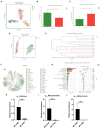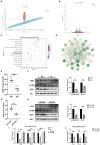Gut microbiota from sigma-1 receptor knockout mice induces depression-like behaviors and modulates the cAMP/CREB/BDNF signaling pathway
- PMID: 37089558
- PMCID: PMC10116000
- DOI: 10.3389/fmicb.2023.1143648
Gut microbiota from sigma-1 receptor knockout mice induces depression-like behaviors and modulates the cAMP/CREB/BDNF signaling pathway
Abstract
Introduction: Depression is a common mental disorder that affects approximately 350 million people worldwide. Much remains unknown about the molecular mechanisms underlying this complex disorder. Sigma-1 receptor (Sig-1R) is expressed at high levels in the central nervous system. Increasing evidence has demonstrated a close association between the Sig-1R and depression. Recently, research has suggested that the gut microbiota may play a crucial role in the development of depression.
Methods: Male Sig-1R knockout (Sig-1R KO) and wild-type (WT) mice were used for this study. All transgenic mice were of a pure C57BL/6J background. Mice received a daily gavage of vancomycin (100 mg/kg), neomycin sulfate (200 mg/kg), metronidazole (200 mg/kg), and ampicillin (200 mg/kg) for one week to deplete gut microbiota. Fecal microbiota transplantation (FMT) was conducted to assess the effects of gut microbiota. Depression-like behaviors was evaluated by tail suspension test (TST), forced swimming test (FST) and sucrose preference test (SPT). Gut microbiota was analyzed by 16s rRNA and hippocampal transcriptome changes were assessed by RNA-seq.
Results: We found that Sig-1R knockout induced depression-like behaviors in mice, including a significant reduction in immobility time and an increase in latency to immobility in the FST and TST, which was reversed upon clearance of gut microbiota with antibiotic treatment. Sig-1R knockout significantly altered the composition of the gut microbiota. At the genus level, the abundance of Alistipes, Alloprevotella, and Lleibacterium decreased significantly. Gut microbiota dysfunction and depression-like phenotypes in Sig-1R knockout mice could be reproduced through FMT experiments. Additionally, hippocampal RNA sequencing identified multiple KEGG pathways that are associated with depression. We also discovered that the cAMP/CREB/BDNF signaling pathway is inhibited in the Sig-1R KO group along with lower expression of neurotrophic factors including CTNF, TGF-α and NGF. Fecal bacteria transplantation from Sig-1R KO mice also inhibited cAMP/CREB/BDNF signaling pathway.
Discussion: In our study, we found that the gut-brain axis may be a potential mechanism through which Sig-1R regulates depression-like behaviors. Our study provides new insights into the mechanisms by which Sig-1R regulates depression and further supports the concept of the gut-brain axis.
Keywords: BDNF; FMT; SIGMAR1; antibiotic; depression-like behaviors; gut microbiota.
Copyright © 2023 Li, Liu, Li, Liu, Yang, Chen, Zhang, Xie and Wang.
Conflict of interest statement
The authors declare that the research was conducted in the absence of any commercial or financial relationships that could be construed as a potential conflict of interest.
Figures






Similar articles
-
Persimmon leaf extract alleviates chronic social defeat stress-induced depressive-like behaviors by preventing dendritic spine loss via inhibition of serotonin reuptake in mice.Chin Med. 2022 Jun 6;17(1):65. doi: 10.1186/s13020-022-00609-4. Chin Med. 2022. PMID: 35668445 Free PMC article.
-
Fndc5/irisin deficiency leads to dysbiosis of gut microbiota contributing to the depressive-like behaviors in mice.Brain Res. 2023 Nov 15;1819:148537. doi: 10.1016/j.brainres.2023.148537. Epub 2023 Aug 15. Brain Res. 2023. PMID: 37591459
-
Stimulation of astrocytic sigma-1 receptor is sufficient to ameliorate inflammation- induced depression.Behav Brain Res. 2021 Jul 23;410:113344. doi: 10.1016/j.bbr.2021.113344. Epub 2021 May 4. Behav Brain Res. 2021. PMID: 33961912
-
Stimulation of the Sigma-1 Receptor and the Effects on Neurogenesis and Depressive Behaviors in Mice.Adv Exp Med Biol. 2017;964:201-211. doi: 10.1007/978-3-319-50174-1_14. Adv Exp Med Biol. 2017. PMID: 28315273 Review.
-
BDNF/CREB signaling pathway contribution in depression pathogenesis: A survey on the non-pharmacological therapeutic opportunities for gut microbiota dysbiosis.Brain Res Bull. 2024 Feb;207:110882. doi: 10.1016/j.brainresbull.2024.110882. Epub 2024 Jan 19. Brain Res Bull. 2024. PMID: 38244808 Review.
Cited by
-
Nutritional Strategies in Major Depression Disorder: From Ketogenic Diet to Modulation of the Microbiota-Gut-Brain Axis.Mol Neurobiol. 2025 Mar;62(3):2973-2994. doi: 10.1007/s12035-024-04446-4. Epub 2024 Aug 28. Mol Neurobiol. 2025. PMID: 39192045 Review.
-
Citraconate promotes the malignant progression of colorectal cancer by inhibiting ferroptosis.Am J Cancer Res. 2024 Jun 15;14(6):2790-2804. doi: 10.62347/LWRS3363. eCollection 2024. Am J Cancer Res. 2024. PMID: 39005662 Free PMC article.
-
The Influence of Intestinal Microbiota on BDNF Levels.Nutrients. 2024 Aug 29;16(17):2891. doi: 10.3390/nu16172891. Nutrients. 2024. PMID: 39275207 Free PMC article. Review.
-
The role of 5-HTergic neuron activation in the rapid antidepressant-like effects of hypidone hydrochloride (YL-0919) in mice.Front Pharmacol. 2024 Sep 6;15:1428485. doi: 10.3389/fphar.2024.1428485. eCollection 2024. Front Pharmacol. 2024. PMID: 39309007 Free PMC article.
-
Nerve growth factor: what can surgeons and oncologists learn from a neurological and psychological biomarker?Mol Med. 2025 Aug 9;31(1):276. doi: 10.1186/s10020-025-01333-z. Mol Med. 2025. PMID: 40783715 Free PMC article. Review.
References
-
- Barco A., Patterson S. L., Alarcon J. M., Gromova P., Mata-Roig M., Morozov A., et al. . (2005). Gene expression profiling of facilitated l-ltp in vp16-creb mice reveals that bdnf is critical for the maintenance of ltp and its synaptic capture. Neuron 48, 123–137. doi: 10.1016/j.neuron.2005.09.005, PMID: - DOI - PubMed
LinkOut - more resources
Full Text Sources
Research Materials
Miscellaneous

